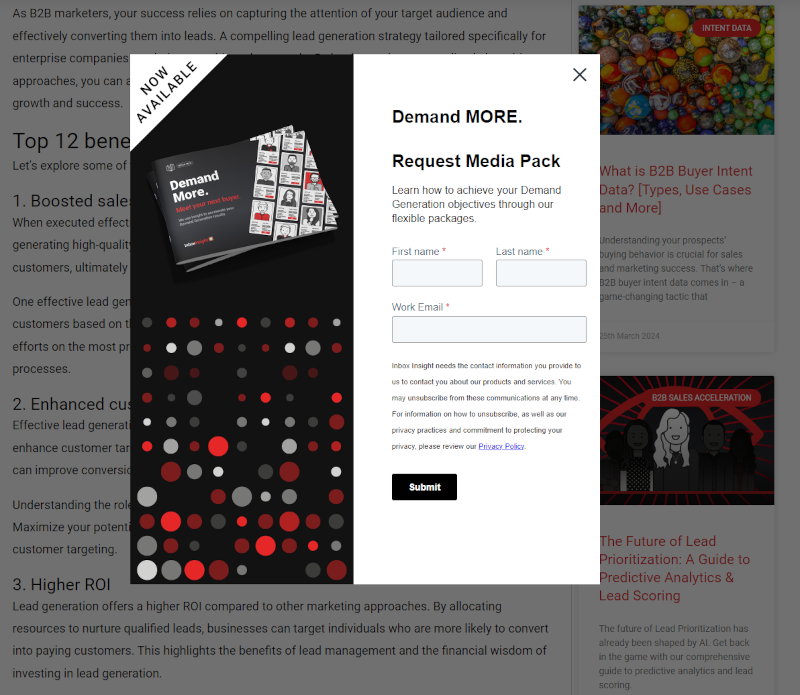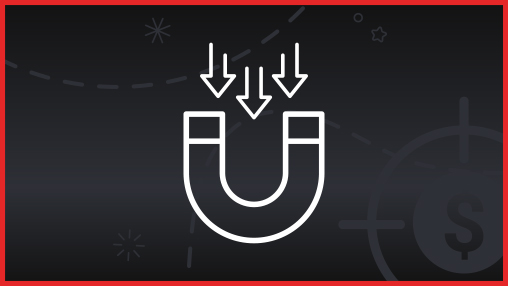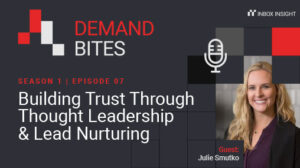Lead generation through high-quality lead magnets is crucial for the success of any B2B business. These magnets have proven to be among the most effective strategies for captivating and engaging potential leads, underscoring their significance.
Our guide explores lead magnets and provides you with a rich compilation of examples. These ideas can be seamlessly incorporated into your marketing efforts, empowering you to accelerate your B2B sales and achieve rapid growth.
- Understanding lead magnets
- Why lead magnets matter
- What makes a good lead magnet?
- How many lead magnets should I have?
- Highly effective lead magnet ideas
- Creating and implementing lead magnets
- Are lead magnets GDPR and CCPA compliant?
What are lead magnets?
Lead magnets are invaluable assets or propositions that businesses offer prospective clients in exchange for their contact details – typically an email address. The main goal of a lead magnet is to draw in visitors, enhance engagement, and increase the chances of turning prospects into loyal customers.
For companies and prospects alike, lead magnets are a strategic win-win. Prospects gain access to valuable resources while businesses grow their contact lists and amplify their lead generation efforts, boosting conversion potential.
Why lead magnets matter in B2B
In B2B, the purchasing path is often complex and prolonged compared to B2C. B2B clients typically require more information and reassurance before making a commitment to purchase. This is where a well-crafted B2B lead magnet can become a game-changer. Statistically, 50% of marketers who employ lead magnets report higher conversion rates, highlighting the importance of these tools for optimizing the sales funnel.
By dispensing valuable content or resources as lead magnets, B2B organizations can proficiently nurture their prospects with insightful ideas and guide them through the purchasing process, ultimately resulting in a transaction. This statistic underscores the efficacy of lead magnets in the B2B space, showcasing their role in driving conversions and potentially increasing revenue.
What makes a good lead magnet?
Successful lead magnets in B2B marketing offer significant value to their target audience, enticing potential customers to provide their contact information willingly. These lead magnets should provide solutions, expert insights, or more efficient ways of doing things to attract high-quality leads genuinely interested in what a company offers.
Key elements of an effective lead magnet
- Problem-solving: When creating a lead magnet, it is crucial to address a specific challenge or problem that your target audience faces. By offering a solution to their pain points, you can capture their attention and position yourself as a valuable resource
- Quick benefits: In order to engage your audience and drive immediate action, your lead magnet should provide solutions that users can implement quickly for instant results. By offering tangible benefits, you can increase the perceived value of your lead magnet
- Specific focus: To ensure maximum effectiveness, it’s important to concentrate on one area of expertise rather than trying to cover multiple topics. By focusing on a specific niche, you can demonstrate your expertise and establish yourself as a trusted authority in that particular area
- Ease of understanding: Your lead magnet should present content that’s concise, clear, and easy for users to comprehend. Avoid using jargon or technical language that may confuse your audience
- High value: A successful lead magnet goes beyond mere appearance and delivers substantial value to the user. Make sure that your lead magnet offers valuable insights, practical tips, or exclusive resources that your target audience cannot easily find elsewhere
- Immediate access: To encourage user engagement, it’s essential to grant instant access to your lead magnet upon submission of their contact information. Avoid any unnecessary delays or complicated steps. By providing instant access, you can accelerate the conversion process and nurture leads more effectively
- Demonstrate expertise: Showcase your industry knowledge or unique value proposition in your lead magnet. This will help establish credibility and trust with your audience. By positioning yourself as an industry expert, you can differentiate yourself from competitors and build relationships with prospective customers
How many lead magnets should I have?
It’s crucial to have multiple lead magnets tailored to your target audience. While there isn’t a specific number, focusing on quality over quantity is key. Create valuable lead magnets that directly address specific pain points and challenges. By monitoring their performance, you can refine your approach and achieve better results. Remember, it’s about delivering segmented lead magnets that provide genuine value to your audience.
17 highly effective lead magnet ideas for B2B marketers
Attracting and engaging potential customers is crucial for driving growth. Here are some highly effective lead magnet examples to consider:
1. Case studies
Case studies demonstrate your success and build credibility by detailing how your solutions have helped other businesses thrive.
2. Checklists
These straightforward and practical tools provide users with a methodical approach to executing specific tasks. For example, a B2B software firm might offer a checklist as a lead magnet example for deploying a new software system.
3. Media pack
Offering a media kit as a lead magnet provides potential customers with a comprehensive overview of your brand, products, and services, empowering them to make informed decisions and effectively communicate your value proposition. This resource can also help attract high-quality leads and foster successful B2B partnerships.

4. Comprehensive guides
Reports that offer extensive information on specific topics are instrumental in fostering thought leadership. They can bolster your brand’s reputation as an authority in your field and provide considerable value to your potential customers.
5. eBooks
eBooks are a cornerstone of content marketing, allowing businesses to delve into comprehensive insights on a particular topic. By distributing eBooks, a company can establish itself as an authority in its field and deliver significant value to potential customers.
6. First-party research reports
First-party research reports offer invaluable insights for B2B sales. By conducting their own studies and leveraging buyer intent data, businesses can uncover industry trends, customer preferences, and competitive intelligence. These reports provide a strong foundation for informed decision-making, improved targeting, and more effective sales strategies.
7. Free trials and demos
Offering free tools or trials allows prospects to experience the benefits of your product directly, encouraging them to consider a full purchase.
8. Gated blog posts
Half-gated blog posts are a valuable tool in your B2B lead generation arsenal, offering a simple yet effective way to create compelling content while capturing more leads. By enticing curious readers to unlock the second half of a long post, you not only provide a great user experience but also expand your lead generation efforts by obtaining their contact details.
9. Industry reports
Creating comprehensive reports that analyze market trends, challenges, and opportunities in your industry can be a powerful lead magnet. These reports provide valuable insights and establish your brand as an authority.
10. Infographics
Infographics attract attention by simplifying complex data into visual formats, making information easy to understand and share.
11. Interactive quizzes
Interactive quizzes that evaluate the user’s knowledge or identify pain points can be engaging lead magnets. B2B professionals are interested in understanding their strengths and weaknesses, and offering an assessment that provides personalized insights can be highly effective for lead generation.
12. Online Courses
Developing online courses related to your industry or specific skill sets can position your brand as an expert resource. B2B professionals are always seeking opportunities for professional development, and offering free or paid online courses can be an effective way to generate leads.
13. Playbooks
Playbooks serve as strategic guides within content marketing and sales enablement. They offer businesses in the B2B sector a clear pathway to achieve specific objectives through meticulous strategic planning and execution.
14. Podcasts
Hosting regular podcasts or webcasts where you share industry insights, trends, and best practices can be a valuable lead magnet. B2B professionals can listen or watch at their convenience and gain actionable knowledge while engaging with your brand.
15. Templates
Templates are invaluable tools that help users save time and effort by providing a predefined framework for various tasks. For example, a B2B marketing company might offer a content strategy template.
16. Webinars
Interactive webinars provide valuable learning and networking opportunities. They offer live engagement and post-event recordings for continued lead generation.
17. Whitepapers
Whitepapers are authoritative tools that provide in-depth research and data-driven insights on specific topics. They are particularly effective in the B2B sector, where data-informed decision-making is paramount.
Remember, when selecting lead magnets, it’s essential to align them with your target audience’s needs and preferences. Conducting research and leveraging data-driven insights about your ideal customer will help you create lead magnets that resonate and drive results.
Creating and implementing lead magnets
To create an effective lead magnet, follow these key steps:
Understanding your audience and crafting your lead magnet
- Identify pain points: Conduct thorough research using surveys, reports, and direct feedback to understand your audience’s needs. Utilize data-driven insights to create detailed buyer personas, which will guide the tailoring of your lead magnet to address specific pain points and preferences
- Tailor resources: Develop a resource directly addressing identified pain points, ensuring it’s valuable enough to incentivize contact information exchange
Crafting your lead magnet
- Add value: Provide a solution or substantial benefit, such as an eBook, webinar, discount code, or exclusive video to entice users to join your email list
- Ensure accessibility: Make it easily accessible with a simple access process
- Design for clarity: Prioritize clear, professional design and straightforward language
Optimizing visibility
- Website integration: Seamlessly integrate your lead magnet into your website
- Landing pages: Create dedicated landing pages with persuasive copy and a user-friendly form that prompts visitors to enter their email address in exchange for the lead magnet
Promotion strategies
- Utilize a mix of strategies: Combine targeted emails, content marketing, social media promotion, and SEO
- Leverage partners for targeted outreach: Publishers and demand generation partners can help you syndicate your content and generate more qualified leads from your ideal customer profile or target accounts
Engaging leads and monitoring
- Immediate acknowledgment: Send an automated thank-you email to acknowledge receipt of the lead’s information
- Follow-up sequence: Develop a series of emails to educate leads about your products or services
- Monitor and tweak: Use analytics to refine your approach based on data for improved conversion rates
By following these practical steps, you can create and implement effective lead magnets that attract and guide leads through the sales funnel towards becoming paying customers. Continually test and refine your approach to achieve the best results.
Are lead magnets GDPR and CCPA compliant?
Lead magnets can be made compliant with both GDPR and CCPA by following best practices that prioritize user consent, data protection, and transparency. Here are some key considerations and best practices to ensure compliance when using lead magnets:
- Clear consent: Obtain explicit and informed consent from users before collecting their personal data for lead magnets. Clearly explain the purpose of data collection and how it will be used. Implement an opt-in mechanism that requires users to actively give their consent
- Privacy notices: Provide clear and accessible privacy notices that outline how you collect, use, share, and protect the personal data gathered through lead magnets. Include information about individuals’ rights, such as the right to access, rectify, or delete their data
- Data minimization: Only collect the minimum amount of personal data necessary for the intended purpose of the lead magnet. Avoid asking for excessive or unnecessary information
- Opt-out mechanism: Give users the option to easily opt out of further communication or the sale of their personal information. Include a prominent “unsubscribe” link or “do not sell my personal information” option in your communications
- Security measures: Implement appropriate security measures to protect the personal data collected through lead magnets. This includes encrypting data, securing storage, and regularly monitoring access to prevent unauthorized use or disclosure
- Data subject rights: Be prepared to respond to users’ requests to exercise their rights under GDPR and CCPA, such as accessing, rectifying, or deleting their personal data. Establish processes to verify individuals’ identities and handle these requests within the required timeframes
- Vendor management: If you share personal data collected through lead magnets with third-party vendors or service providers, ensure that they also adhere to GDPR and CCPA requirements. Have proper data processing agreements in place and carefully select partners who prioritize data protection
By implementing these best practices, you can ensure that your lead magnets are GDPR and CCPA compliant, allowing you to build trust with your users and maintain compliance with important data privacy regulations. Remember to stay up to date with any updates or changes to GDPR and CCPA to ensure ongoing compliance.
Final thoughts
Lead magnets are a powerful tool for B2B companies to generate high-quality leads. By offering valuable resources in exchange for contact details, lead magnets attract potential clients, guide them through the sales funnel, and increase conversion probabilities.
With an abundance of great lead magnet ideas available, businesses have the opportunity to select the best lead magnets that align with their marketing goals and audience requirements. Implementing various types of lead magnets effectively can significantly enhance lead generation strategies and drive business growth.
Looking for more valuable insights? Visit our lead generation category curated by our team of lead generation specialists.






